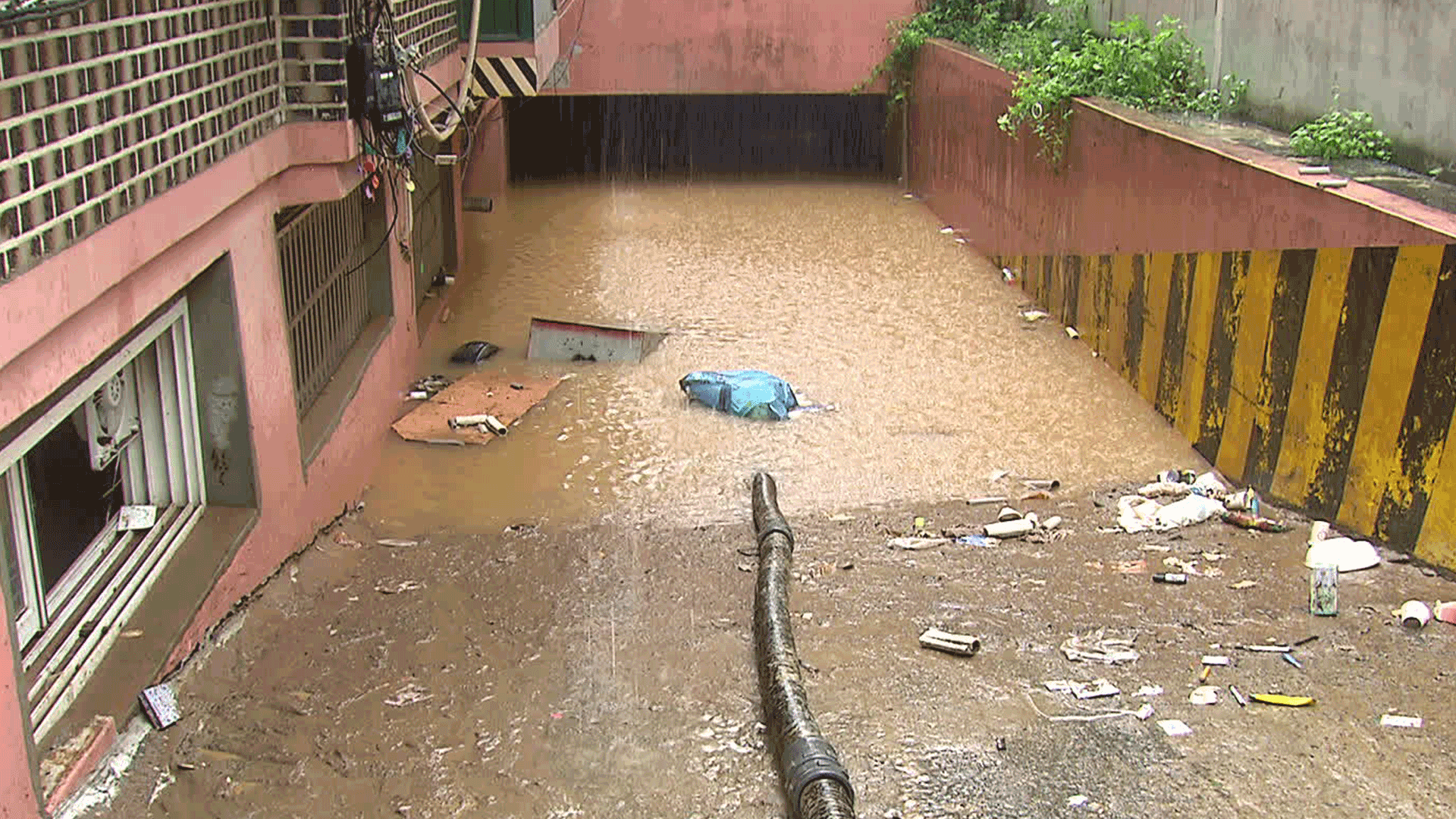[Anchor]
Three years ago, record rainfall in Seoul caused flooding in semi-basement homes, resulting in the loss of several lives.
For the first time, a comprehensive survey has been conducted to determine how many households live in these semi-basements, and the results show that the number is much higher than previously estimated.
First, reporter Yoon Ah-rim has the report.
[Report]
The semi-basement home where three family members lost their lives as rainwater rushed in through the windows.
Even three years later, it remains vacant.
[Nearby resident/voice altered: "I occasionally pass by and I know no one lives there."]
Local residents recall that day every time it rains.
[Semi-basement resident in Gwanak-gu, Seoul: "I couldn't sleep, worrying if it would rain like before, so I couldn't get a wink of sleep."]
There are 398,000 households living in semi-basements nationwide.
That accounts for 1.8% of all households.
This is the scale revealed by the National Statistical Office's first comprehensive survey this year.
Until now, the number of semi-basement households was estimated based on a sample survey of about 20% of all households, which was 70,000 fewer than this comprehensive survey.
The largest number of semi-basement households is in Seoul, with 245,000, and 97.5% are concentrated in the metropolitan area.
Compared to the sample survey conducted four years ago, the number in the metropolitan area has increased, while most other regions have decreased.
[Lee Won-ho/Head researcher at the Korea Urban Research Institute: "(In Seoul) there are issues with rising rents, and ultimately, as affordable housing for low-income urban residents disappears due to development,"]
In Seoul, the number of semi-basement households is 7,500 more than the results of a self-conducted comprehensive survey by the city after the tragedy three years ago.
The Seoul city government stated that their survey method differed from that of the National Statistical Office, but it means they overlooked 7,500 semi-basement households even after conducting a comprehensive survey for flood prevention measures.
In Gwanak-gu, where the tragedy occurred three years ago, there are still about 30,000 households living in semi-basements, the highest in the country.
KBS News, Yoon Ah-rim.
[Anchor]
After the tragic incident three years ago, the Seoul city government proposed a law to prevent semi-basements from being used as residential spaces.
Additionally, the city has stated that it will work to eliminate existing semi-basement homes.
However, the results do not seem significant.
Reporter Lee Se-jung has investigated the reasons.
[Report]
At the bottom of seven stairs, we arrive at the semi-basement home of 79-year-old Kim Seong-chil.
This year, with the help of an organization, he barely managed to re-wallpaper his home.
[Kim Seong-chil/Dongjak-gu, Seoul: "(In a semi-basement) it's damp and my health is not good. The mold makes me feel mentally and emotionally unwell."]
To move above ground, he needs to secure a deposit, but his only income is from his pension, making it impossible to consider moving above ground.
This is the reason he moved back to a semi-basement home six months ago.
[Kim Seong-chil/Dongjak-gu, Seoul: "(Above ground) the deposit is too expensive; it has to be at least 100 million won. It's out of the question... I don't have much, so looking for alternatives is also difficult because the rents here are quite high."]
The Seoul city government provides support of 200,000 won per month for up to six years for existing semi-basement households that move above ground.
However, currently, only about 1,100 households are receiving this support.
The government also supports deposits of up to 80 million won, but only 50 million won is interest-free, and the rest must bear interest.
The average income of semi-basement households in Seoul is about half that of all households, making it realistically difficult to decide to move when considering deposit interest and moving costs.
If semi-basements are eliminated, the government supports remodeling costs for landlords, but many landlords are reluctant to give up the monthly rent they receive.
[Sung Dong-hoon/Social worker at the Housing Welfare Alliance: "Those who cannot pay rental deposits or rent tend to move to worse conditions, like goshiwons or small rooms, but even the relatively decent semi-basements continue to have tenants."]
Even when someone leaves, semi-basements are quickly filled again.
In the past three years, only 8,700 semi-basement homes have disappeared in Seoul.
KBS News, Lee Se-jung.
Three years ago, record rainfall in Seoul caused flooding in semi-basement homes, resulting in the loss of several lives.
For the first time, a comprehensive survey has been conducted to determine how many households live in these semi-basements, and the results show that the number is much higher than previously estimated.
First, reporter Yoon Ah-rim has the report.
[Report]
The semi-basement home where three family members lost their lives as rainwater rushed in through the windows.
Even three years later, it remains vacant.
[Nearby resident/voice altered: "I occasionally pass by and I know no one lives there."]
Local residents recall that day every time it rains.
[Semi-basement resident in Gwanak-gu, Seoul: "I couldn't sleep, worrying if it would rain like before, so I couldn't get a wink of sleep."]
There are 398,000 households living in semi-basements nationwide.
That accounts for 1.8% of all households.
This is the scale revealed by the National Statistical Office's first comprehensive survey this year.
Until now, the number of semi-basement households was estimated based on a sample survey of about 20% of all households, which was 70,000 fewer than this comprehensive survey.
The largest number of semi-basement households is in Seoul, with 245,000, and 97.5% are concentrated in the metropolitan area.
Compared to the sample survey conducted four years ago, the number in the metropolitan area has increased, while most other regions have decreased.
[Lee Won-ho/Head researcher at the Korea Urban Research Institute: "(In Seoul) there are issues with rising rents, and ultimately, as affordable housing for low-income urban residents disappears due to development,"]
In Seoul, the number of semi-basement households is 7,500 more than the results of a self-conducted comprehensive survey by the city after the tragedy three years ago.
The Seoul city government stated that their survey method differed from that of the National Statistical Office, but it means they overlooked 7,500 semi-basement households even after conducting a comprehensive survey for flood prevention measures.
In Gwanak-gu, where the tragedy occurred three years ago, there are still about 30,000 households living in semi-basements, the highest in the country.
KBS News, Yoon Ah-rim.
[Anchor]
After the tragic incident three years ago, the Seoul city government proposed a law to prevent semi-basements from being used as residential spaces.
Additionally, the city has stated that it will work to eliminate existing semi-basement homes.
However, the results do not seem significant.
Reporter Lee Se-jung has investigated the reasons.
[Report]
At the bottom of seven stairs, we arrive at the semi-basement home of 79-year-old Kim Seong-chil.
This year, with the help of an organization, he barely managed to re-wallpaper his home.
[Kim Seong-chil/Dongjak-gu, Seoul: "(In a semi-basement) it's damp and my health is not good. The mold makes me feel mentally and emotionally unwell."]
To move above ground, he needs to secure a deposit, but his only income is from his pension, making it impossible to consider moving above ground.
This is the reason he moved back to a semi-basement home six months ago.
[Kim Seong-chil/Dongjak-gu, Seoul: "(Above ground) the deposit is too expensive; it has to be at least 100 million won. It's out of the question... I don't have much, so looking for alternatives is also difficult because the rents here are quite high."]
The Seoul city government provides support of 200,000 won per month for up to six years for existing semi-basement households that move above ground.
However, currently, only about 1,100 households are receiving this support.
The government also supports deposits of up to 80 million won, but only 50 million won is interest-free, and the rest must bear interest.
The average income of semi-basement households in Seoul is about half that of all households, making it realistically difficult to decide to move when considering deposit interest and moving costs.
If semi-basements are eliminated, the government supports remodeling costs for landlords, but many landlords are reluctant to give up the monthly rent they receive.
[Sung Dong-hoon/Social worker at the Housing Welfare Alliance: "Those who cannot pay rental deposits or rent tend to move to worse conditions, like goshiwons or small rooms, but even the relatively decent semi-basements continue to have tenants."]
Even when someone leaves, semi-basements are quickly filled again.
In the past three years, only 8,700 semi-basement homes have disappeared in Seoul.
KBS News, Lee Se-jung.
■ 제보하기
▷ 카카오톡 : 'KBS제보' 검색, 채널 추가
▷ 전화 : 02-781-1234, 4444
▷ 이메일 : kbs1234@kbs.co.kr
▷ 유튜브, 네이버, 카카오에서도 KBS뉴스를 구독해주세요!
- Rise in semi-basement homes
-
- 입력 2025-08-08 00:19:24

[Anchor]
Three years ago, record rainfall in Seoul caused flooding in semi-basement homes, resulting in the loss of several lives.
For the first time, a comprehensive survey has been conducted to determine how many households live in these semi-basements, and the results show that the number is much higher than previously estimated.
First, reporter Yoon Ah-rim has the report.
[Report]
The semi-basement home where three family members lost their lives as rainwater rushed in through the windows.
Even three years later, it remains vacant.
[Nearby resident/voice altered: "I occasionally pass by and I know no one lives there."]
Local residents recall that day every time it rains.
[Semi-basement resident in Gwanak-gu, Seoul: "I couldn't sleep, worrying if it would rain like before, so I couldn't get a wink of sleep."]
There are 398,000 households living in semi-basements nationwide.
That accounts for 1.8% of all households.
This is the scale revealed by the National Statistical Office's first comprehensive survey this year.
Until now, the number of semi-basement households was estimated based on a sample survey of about 20% of all households, which was 70,000 fewer than this comprehensive survey.
The largest number of semi-basement households is in Seoul, with 245,000, and 97.5% are concentrated in the metropolitan area.
Compared to the sample survey conducted four years ago, the number in the metropolitan area has increased, while most other regions have decreased.
[Lee Won-ho/Head researcher at the Korea Urban Research Institute: "(In Seoul) there are issues with rising rents, and ultimately, as affordable housing for low-income urban residents disappears due to development,"]
In Seoul, the number of semi-basement households is 7,500 more than the results of a self-conducted comprehensive survey by the city after the tragedy three years ago.
The Seoul city government stated that their survey method differed from that of the National Statistical Office, but it means they overlooked 7,500 semi-basement households even after conducting a comprehensive survey for flood prevention measures.
In Gwanak-gu, where the tragedy occurred three years ago, there are still about 30,000 households living in semi-basements, the highest in the country.
KBS News, Yoon Ah-rim.
[Anchor]
After the tragic incident three years ago, the Seoul city government proposed a law to prevent semi-basements from being used as residential spaces.
Additionally, the city has stated that it will work to eliminate existing semi-basement homes.
However, the results do not seem significant.
Reporter Lee Se-jung has investigated the reasons.
[Report]
At the bottom of seven stairs, we arrive at the semi-basement home of 79-year-old Kim Seong-chil.
This year, with the help of an organization, he barely managed to re-wallpaper his home.
[Kim Seong-chil/Dongjak-gu, Seoul: "(In a semi-basement) it's damp and my health is not good. The mold makes me feel mentally and emotionally unwell."]
To move above ground, he needs to secure a deposit, but his only income is from his pension, making it impossible to consider moving above ground.
This is the reason he moved back to a semi-basement home six months ago.
[Kim Seong-chil/Dongjak-gu, Seoul: "(Above ground) the deposit is too expensive; it has to be at least 100 million won. It's out of the question... I don't have much, so looking for alternatives is also difficult because the rents here are quite high."]
The Seoul city government provides support of 200,000 won per month for up to six years for existing semi-basement households that move above ground.
However, currently, only about 1,100 households are receiving this support.
The government also supports deposits of up to 80 million won, but only 50 million won is interest-free, and the rest must bear interest.
The average income of semi-basement households in Seoul is about half that of all households, making it realistically difficult to decide to move when considering deposit interest and moving costs.
If semi-basements are eliminated, the government supports remodeling costs for landlords, but many landlords are reluctant to give up the monthly rent they receive.
[Sung Dong-hoon/Social worker at the Housing Welfare Alliance: "Those who cannot pay rental deposits or rent tend to move to worse conditions, like goshiwons or small rooms, but even the relatively decent semi-basements continue to have tenants."]
Even when someone leaves, semi-basements are quickly filled again.
In the past three years, only 8,700 semi-basement homes have disappeared in Seoul.
KBS News, Lee Se-jung.
Three years ago, record rainfall in Seoul caused flooding in semi-basement homes, resulting in the loss of several lives.
For the first time, a comprehensive survey has been conducted to determine how many households live in these semi-basements, and the results show that the number is much higher than previously estimated.
First, reporter Yoon Ah-rim has the report.
[Report]
The semi-basement home where three family members lost their lives as rainwater rushed in through the windows.
Even three years later, it remains vacant.
[Nearby resident/voice altered: "I occasionally pass by and I know no one lives there."]
Local residents recall that day every time it rains.
[Semi-basement resident in Gwanak-gu, Seoul: "I couldn't sleep, worrying if it would rain like before, so I couldn't get a wink of sleep."]
There are 398,000 households living in semi-basements nationwide.
That accounts for 1.8% of all households.
This is the scale revealed by the National Statistical Office's first comprehensive survey this year.
Until now, the number of semi-basement households was estimated based on a sample survey of about 20% of all households, which was 70,000 fewer than this comprehensive survey.
The largest number of semi-basement households is in Seoul, with 245,000, and 97.5% are concentrated in the metropolitan area.
Compared to the sample survey conducted four years ago, the number in the metropolitan area has increased, while most other regions have decreased.
[Lee Won-ho/Head researcher at the Korea Urban Research Institute: "(In Seoul) there are issues with rising rents, and ultimately, as affordable housing for low-income urban residents disappears due to development,"]
In Seoul, the number of semi-basement households is 7,500 more than the results of a self-conducted comprehensive survey by the city after the tragedy three years ago.
The Seoul city government stated that their survey method differed from that of the National Statistical Office, but it means they overlooked 7,500 semi-basement households even after conducting a comprehensive survey for flood prevention measures.
In Gwanak-gu, where the tragedy occurred three years ago, there are still about 30,000 households living in semi-basements, the highest in the country.
KBS News, Yoon Ah-rim.
[Anchor]
After the tragic incident three years ago, the Seoul city government proposed a law to prevent semi-basements from being used as residential spaces.
Additionally, the city has stated that it will work to eliminate existing semi-basement homes.
However, the results do not seem significant.
Reporter Lee Se-jung has investigated the reasons.
[Report]
At the bottom of seven stairs, we arrive at the semi-basement home of 79-year-old Kim Seong-chil.
This year, with the help of an organization, he barely managed to re-wallpaper his home.
[Kim Seong-chil/Dongjak-gu, Seoul: "(In a semi-basement) it's damp and my health is not good. The mold makes me feel mentally and emotionally unwell."]
To move above ground, he needs to secure a deposit, but his only income is from his pension, making it impossible to consider moving above ground.
This is the reason he moved back to a semi-basement home six months ago.
[Kim Seong-chil/Dongjak-gu, Seoul: "(Above ground) the deposit is too expensive; it has to be at least 100 million won. It's out of the question... I don't have much, so looking for alternatives is also difficult because the rents here are quite high."]
The Seoul city government provides support of 200,000 won per month for up to six years for existing semi-basement households that move above ground.
However, currently, only about 1,100 households are receiving this support.
The government also supports deposits of up to 80 million won, but only 50 million won is interest-free, and the rest must bear interest.
The average income of semi-basement households in Seoul is about half that of all households, making it realistically difficult to decide to move when considering deposit interest and moving costs.
If semi-basements are eliminated, the government supports remodeling costs for landlords, but many landlords are reluctant to give up the monthly rent they receive.
[Sung Dong-hoon/Social worker at the Housing Welfare Alliance: "Those who cannot pay rental deposits or rent tend to move to worse conditions, like goshiwons or small rooms, but even the relatively decent semi-basements continue to have tenants."]
Even when someone leaves, semi-basements are quickly filled again.
In the past three years, only 8,700 semi-basement homes have disappeared in Seoul.
KBS News, Lee Se-jung.
-
-

이세중 기자 center@kbs.co.kr
이세중 기자의 기사 모음
-
이 기사가 좋으셨다면
-
좋아요
0
-
응원해요
0
-
후속 원해요
0













![[단독] “다이아 큰 거라 놀라셨다”…김건희 영장에 담긴 ‘통일교 선물’](/data/layer/904/2025/08/20250807_7zP70m.png)

이 기사에 대한 의견을 남겨주세요.